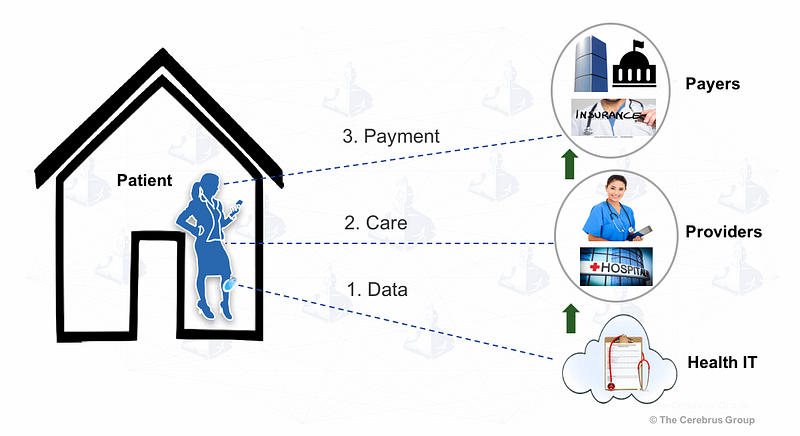IoT and Healthcare: Redesigning Care Pathways
IoT and Healthcare: Redesigning Care Pathways
- Last Updated: December 2, 2024
Hari Harikrishnan
- Last Updated: December 2, 2024



Joining IoT and healthcare and leveraging connectivity to deliver care is not as easy as it seems.
The usual refrain on IoT goes like this:
- You connect a device to the cloud. Data magically flows from the device to the cloud.
- Data may make a stop on the way to the cloud for some local data processing.
- We enjoy the fruits of the data and predictive maintenance and live happily ever after
We are supposed to simply rinse and repeat this process across vast swathes of industries as follows:

Really?!
A reader from the industrial world recently wrote to me:
“Only IT people who live in their cloudy ivory towers and have never been to a factory floor can make up these... stories”.
Managed telephone and managed services in IT is a decades-old business practice. (See the old AT&T managing a phone above). Repeating the same for monitoring machine health in industrial manufacturing can be done, but not easily, as the above reader points out.
However, replicating the same for managing human health remotely requires a leap not just in technology, but in how healthcare is delivered.
Yet, with IoT, hope for better health springs eternal.
Health Monitoring using IoT
So, how can we ensure the successful marriage of IoT and healthcare?
Managed Care and IoT
In healthare, clinical pathways or care pathways are implemented to standardize the delivery of care. A care pathway is a series of processes that reduces variability and improves clinical outcomes for the patient.
Let’s expand the notion of “pathways” to appreciate how IoT can be leveraged in healthcare delivery. The expansion includes the notion that data needs to flow across the players involved in care delivery and money needs to flow to compensate the right parties.
Hence, pathways in IoT-enabled healthcare deal with three areas:
- Data Pathway: With the right sensors (biosensors, wearables, smartphones etc.), patient activity and habits can be monitored, data aggregated and analyzed.
- Care Pathway: Clinical processes need to be designed to optimize the outcome for the patient. These are built based on empirical evidence in the practice of medicine.
- Payment Pathway: This pathway ensures that the care providers get paid for services rendered to the patient. As we know this is a complicated system in many countries.
The three pathways together look like this.
[caption id=" align="aligncenter" width="800"]

Health Complications
Let’s examine the complications in healthcare by examining each pathway.
Data Pathway
Biosensors are not your average flow sensors or vibration sensors. They are for humans. They are sometimes worn. They are mostly mobile. They are specific to body-area. There is a limit to how much a human can wear.
The human is a complex “end-point”, to use IoT jargon. There are many points to monitor. There is no standard baseline, unlike an industrial machine. Establishing the baseline parameters of the patient itself is a big undertaking needing clinical expertise.
Privacy in health is definitely a much more touchy (no pun) subject than in Industrial IoT.
Care Pathway
IoT changes the way data flows into clinical processes. In the non-IoT case, data “flows” only when the patient is at a care facility or when they call in. With IoT, data is always flowing. It is as if the provider gets virtual visits from the patient 24-hours a day!
How should the care provider deal with it? Are they liable if they fail to sense, analyze, and take action throughout? How should they re-design clinical pathways based on this new data flow? What are the best practices and protocols to follow? When should the patient visit a facility or a provider visit the patient at home?
Payment Pathway
Healthcare is unique in each country. Payment systems are varied and complex. In a complex system like the US, there are many payers and administrators — government, private firms, insurance firms, and patients. In industrial IoT, end customers pay the vendor or the vendor’s channel partner for product or services rendered. Simple!
IoT and Healthcare: The Twain Shall Meet
Some may argue that these three pathways exist in every industry that performs remote management of machines and that there are parallels between remote healthcare and doing remote operations. Regardless, the compounded effect of redesigning care delivery around three pathways, each of them non-trivial, is unique to healthcare.Despite all the complications above, the value of IoT in improving health outcomes, delivery efficiencies, and patient experience are not lost on governments and care providers. We are on our way to professionally managed healthcare using IoT, not just consumer-grade wearables for the fitness-conscious.

We will even go beyond the simple model of single provider caring for a patient to a myriad of providers using our personal data and designing new care pathways for us.
I don’t know about you, but I look forward to a new care delivery system anchored on my ever-streaming data.
The Most Comprehensive IoT Newsletter for Enterprises
Showcasing the highest-quality content, resources, news, and insights from the world of the Internet of Things. Subscribe to remain informed and up-to-date.
New Podcast Episode

Moving Past the Pilot Phase in IoT and AI
Related Articles




